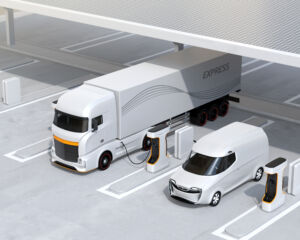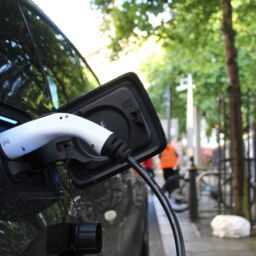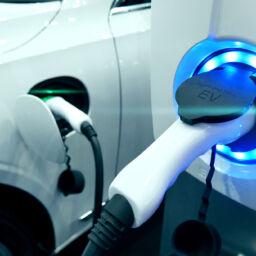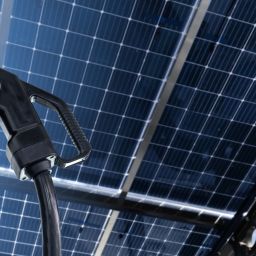The SCF team has written several pieces lately covering the transition to electric passenger vehicles (EVs), how those EVs will be charged, and how the grid will handle all of that new electrical load. In this piece, however, we will be covering the commercial side of the EV marketplace.
 To put this market into perspective, the passenger fleet of vehicles makes up approximately 58% of fuel usage and emissions for all vehicles in the U.S. Commercial vehicles, by way of comparison, make up around 24% of fuel usage and emissions (based on the most recent data from the EPA) Electrifying just the passenger side of the U.S. vehicle fleet, while significantly impactful, will not be enough for the U.S. to reach the recently agreed-upon emission reduction targets set during the COP26 Climate Summit. To meet the overall target of a 50% reduction in fossil fuel emissions in the next 10 years, the U.S. will need an all-in approach, and the commercial transportation fleet is high on that list. Here is a shortlist of vehicle types that fall into this segment:
To put this market into perspective, the passenger fleet of vehicles makes up approximately 58% of fuel usage and emissions for all vehicles in the U.S. Commercial vehicles, by way of comparison, make up around 24% of fuel usage and emissions (based on the most recent data from the EPA) Electrifying just the passenger side of the U.S. vehicle fleet, while significantly impactful, will not be enough for the U.S. to reach the recently agreed-upon emission reduction targets set during the COP26 Climate Summit. To meet the overall target of a 50% reduction in fossil fuel emissions in the next 10 years, the U.S. will need an all-in approach, and the commercial transportation fleet is high on that list. Here is a shortlist of vehicle types that fall into this segment:
- Tractor-trailers (long-haul semi’s)
- Transport vans (last-mile delivery vans like UPS, FedEx, Amazon, etc.)
- Buses
- Specialty trucks (dump trucks, cement mixers, garbage trucks, mail trucks, etc.)
- Liquid transport trucks (includes chemical, fuel, liquid waste, etc.)
The most significant difference between the passenger vehicle fleet and the commercial fleet is the underlying power requirements for each type of vehicle. For passenger cars, the average battery capacity for current models is in the 80-120 kWh range, which will provide anywhere from 250-350 miles of driving range. The simple math for those interested is roughly 3 miles/kWh for passenger vehicles.
The math is very different for long-haul tractor-trailers because of the massive addition of weight from the hauled goods. There are a lot of competing models showing what expected performance would look like for electric semis. Still, many people in this space are using 0.5 miles/kWh as a placeholder for now until significantly more live road-testing can verify the actual range. If we use 0.5 miles/kWh, you can see how much larger the battery requirement will be for tractor-trailers. A typical diesel-powered semi-truck, equipped with dual 150-gallon tanks (300 gallons total) operating at about 7 MPG, has a range of over 2000 miles. Therefore, the limitation for these long-haul trucks is not the fuel but the amount of time the drivers are legally allowed to drive each day (which is typically 11 hours/day). Based on this math, the first thing to note is that long-haul semi-trucks will not be the initial market for commercial EVs. There are still a high percentage of relatively short-haul routes, however, where EVs could participate. Those applications could be final-mile delivery services such as Amazon, Fed-Ex, UPS vans, mail delivery; short-haul trucking (typically from seaports and airports to distribution centers, known as Drayage), and short-haul buses. For these types of applications, a range of about 300-500 miles should be adequate, translating into battery packs of around 250 kWh. These numbers could rise as high as 500 kWh for larger vehicles, but these are still manageable numbers.
 The next question becomes, how will those trucks be charged? For many of them, fleet charging will be the most straightforward path. Each application will have a slightly different setup for charging services, but wherever these vehicles are stationed, many Level III fast chargers will be installed. These chargers will most likely range from 150-350 kW in charging capacity so that even a vehicle with a 400-kWh battery pack could theoretically charge in a little more than an hour. While this seems like a relatively easy solution, it is fraught with several complicating factors that must be considered. Here are a few of those factors:
The next question becomes, how will those trucks be charged? For many of them, fleet charging will be the most straightforward path. Each application will have a slightly different setup for charging services, but wherever these vehicles are stationed, many Level III fast chargers will be installed. These chargers will most likely range from 150-350 kW in charging capacity so that even a vehicle with a 400-kWh battery pack could theoretically charge in a little more than an hour. While this seems like a relatively easy solution, it is fraught with several complicating factors that must be considered. Here are a few of those factors:
- High-capacity fast chargers are not inexpensive, ranging from $50,000-$100,000+ installed, so a fleet operator will not want to install more than they need to. In addition to the cost of the EV Chargers, additional components may be required, including transformer upgrades, new switchgear panels, and potentially new dedicated meters. A careful analysis needs to be completed that will determine the following:
- Total number of vehicles to be charged
- Daily usage per vehicle and the associated energy consumed
- The timing of energy usage
From these variables, a plan can be developed that will allow for the minimum number of EV chargers required and the minimum amount of charging capacity for each charger. This analysis will also help determine how to align those chargers within the facility for maximum ease of use.
- Charging commercial EVs requires a great deal of energy. Charging even a relatively small fleet of vehicles can more than double the electrical usage of a facility and can drive electrical costs through the roof. Therefore, managing how and when those vehicles are charged becomes essential for any commercial EV charging plan. In many areas, demand charges can make up 30-50% of electricity bills and adding large capacity fast chargers can drive up demand, and hence costs, dramatically. The way around this problem is to work with companies that offer fleet charging software that manage the timing and delivery of electricity to the fleet. The competing goals of this software would be to maximize the fleet’s uptime while minimizing the additional electricity costs. One thing to note here is that while a fleet owner’s electricity costs will most certainly rise if these costs are appropriately managed, the offsetting reduction in fuel costs will most certainly outweigh the increased electricity expenses.
- Lastly, planning for potential expansion should also be a goal in any comprehensive EV fleet charging strategy. If equipment upgrades like transformers and switchgears are required to implement an EV charging plan, fleet owners will only want to go through this process once, if possible. Therefore, it is worth spending some time determining if additional vehicles will be added to the fleet in the coming years and planning for maximum capacity now rather than in the future.
In terms of the timing of any broad-scale rollout of commercial EVs, it’s probably going to take longer than many expect. While numerous companies have issued press releases showing newly offered electrified delivery vans and even some semi’s (most noticeably Tesla, Mercedes, and Volvo), mass production for most of these vehicles is still a long way off. Tesla planned on shipping a small number of units in 2021 (approximately 25 in total), but those were delayed until 2022, with new orders expected to be delivered sometime into 2023. Amazon recently announced a 20% stake in the truck manufacturer, Rivian, and provided them with an order for 100,000 electric delivery vans. Public announcements claim that Rivian hopes to have 10% of these vehicles on the road by early 2022, but little information is available about their progress. The commercial side of the EV market looks to be rolling out far behind the passenger market.
This is an incredibly exciting time for EVs (both passenger and commercial), and we will most certainly see a massive push for Fast EV chargers to be installed in the next 2-10 years. Estimates show that we will need over 10 million fast chargers by 2030 to meet the onslaught of new EVs being purchased. If you would like to learn more about adding EV charging to your facility and creating new revenue streams for your organization, please email the team here for more information.











